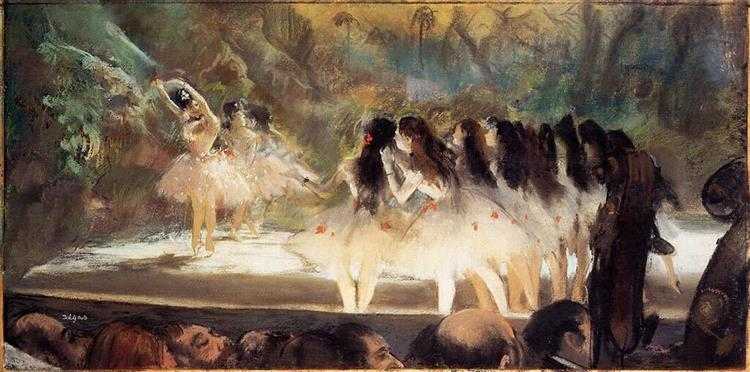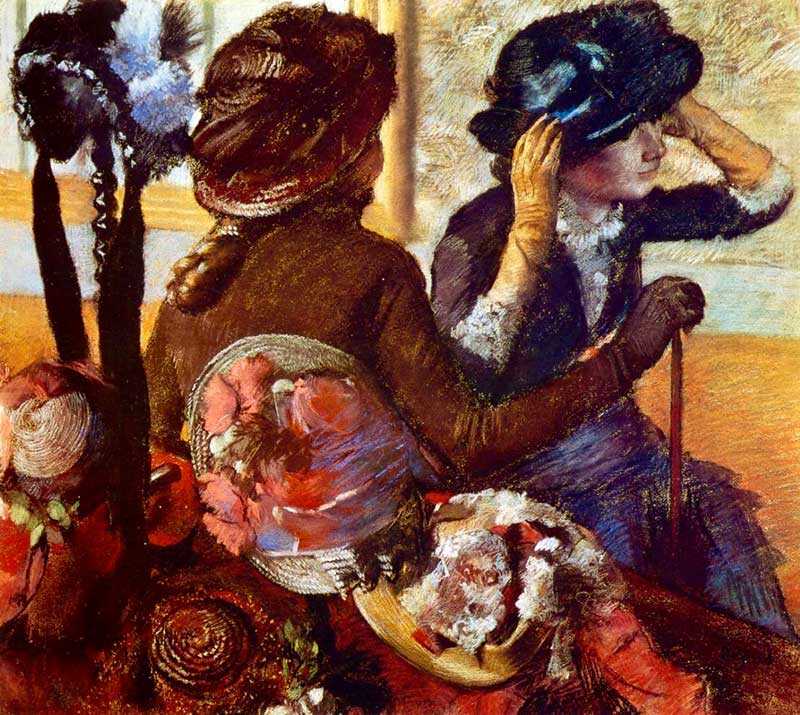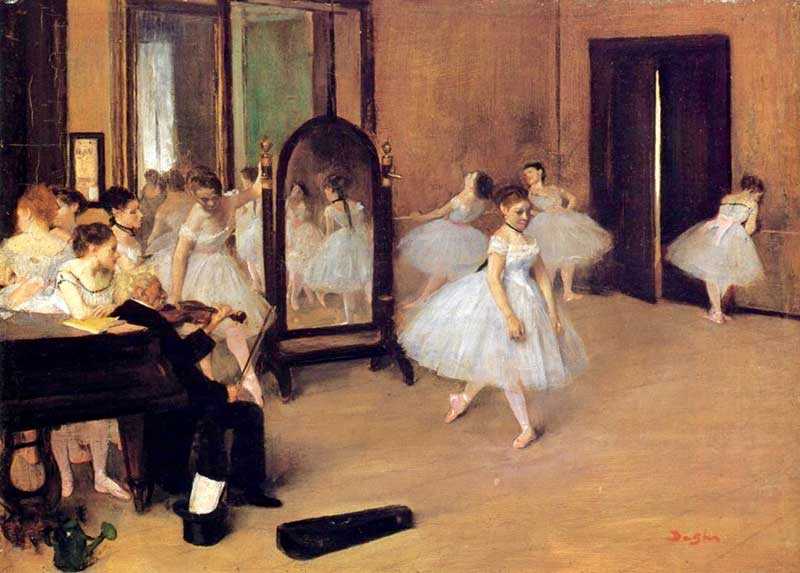1. Young Spartans Exercising (1860)
As a young painter, Degas focused on producing a number of history paintings.
This was the most highly regarded painting genre at the time, enhancing an artist's prospects of success in the important Paris Salon (an annual exhibition organised by the Fine Arts. Degas' Young Spartans Exercising is one such example.
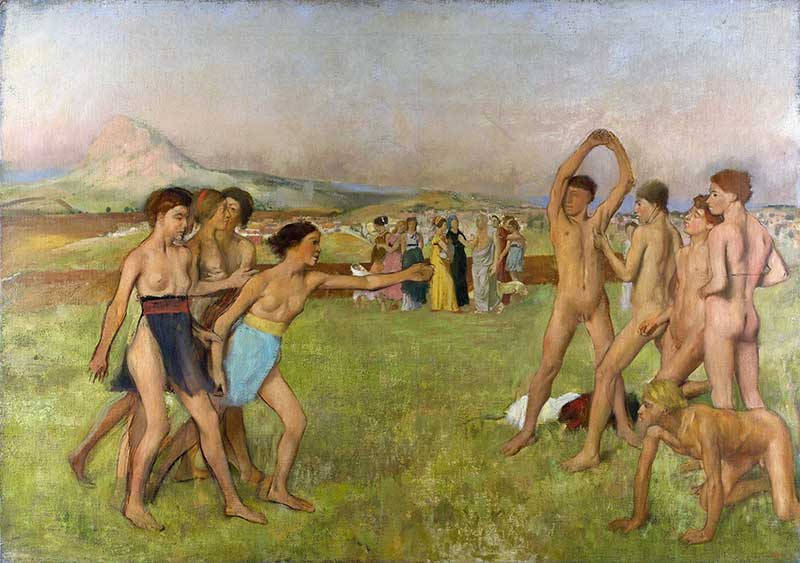
Degas' studio
Though he later transitioned into Impressionist style paintings, Degas kept this work on display in his studio and it remained in his possession for his whole life. This may have been a deliberate technique to prove to visitors that he had the ability to be a great history painter. It was a statement of his talent as an artist.
As his friend Daniel Halévy confided:
“Later in his life, Degas was very attached to this work; he drew it forth from the secret reserves in which he concealed his lifetime’s labours and placed it clearly in view on an easel in front of which he would often stop – a notable honour and a sign of predilection.”
A historical painting?
This painting is noticeably different to the typical academic history paintings from this period, however. Already we can see Degas’ interest in experimenting with novel subjects. The painting draws on an anecdote described by the Roman historian Plutarch about Spartan education, in which girls were expected to engage in exercise with the boys and to challenge them. Degas depicts two groups of nude and semi-nude figures with the boys on the right and the girls on the left.
In this painting, we can see hints of Degas’ later work and his fascination with movement. The poses of the figures have similarities with his paintings of ballerinas and jockeys and one boy is shown on all fours, a position Degas would come to use in his studies of prostitutes.
Where is it now?
Young Spartans Exercising is found in London's National Gallery.
2. The Bellelli Family (1858-67)
This portrait was painted during Degas’ stay in Italy where he trained in classical painting, studying the work of the Italian Masters.
The Bellelli family were relatives of Degas, his paternal aunt, Laure, had married Baron Bellelli and lived with him and their family in Florence.
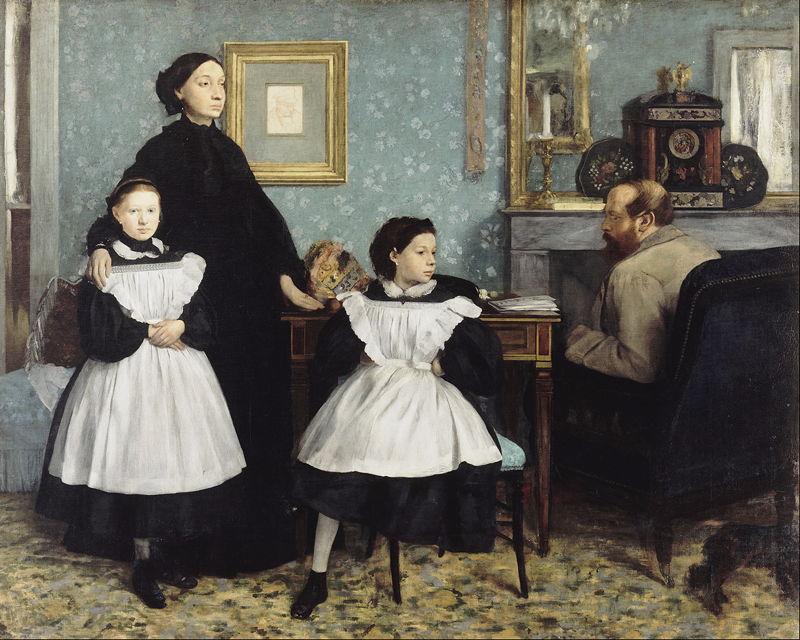
The scene
In the painting, we see the family dressed in mourning clothes following the death of the man whose portrait appears in a painting hung on the wall. Also included are Laure’s two daughters, Giula and Giovanna.
Together with their mother, they stand in a richly decorated contemporary drawing room complete with blue patterned wallpaper and a large gilded mirror above the fireplace. One figure is separate from the group, a man seated and wearing more casual attire.
A matriarchy ...
What is most striking about the figures is the mother’s authoritative stance. She dominates the painting, looking into the distance with a steely gaze. The child to the left echoes her mother’s decorous posture. In contrast, the girl seated in the centre of the painting has one leg crossed under her in a more relaxed, childlike manner.
In this painting, Degas references the portraiture of Flemish artists including Van Dyck, drawing on their symbolic technique of representing the cycle of birth, life and death in their artworks. At the same time, he emphasises the family divisions among the Bellelli’s.
As Degas’ aunt admitted, her home life at this time was
“immensely disagreeable […] living with Gennaro, whose detestable nature you know.”
Degas was one of the first artists to use a formal portrait as a medium for exploring familial tensions. He kept this piece in his studio, passing it to his art dealer in 1913. Upon his death in 1917, the work was sold to the Musée du Luxembourg in Paris.
Where is it now?
The Bellini Family is now housed in Paris' Musee D'Orsay.
3. Orchestra Musicians (1872)
This dramatically cropped painting, with a distinctly modern, photographic style, was one of the first precursors to Degas’ ballerina paintings.
It was inspired by shows at the Paris Opera, where Degas was a regular visitor. This painting gives the impression of being a momentary snapshot, freezing the movement of the dancers and the musicians mid-performance.
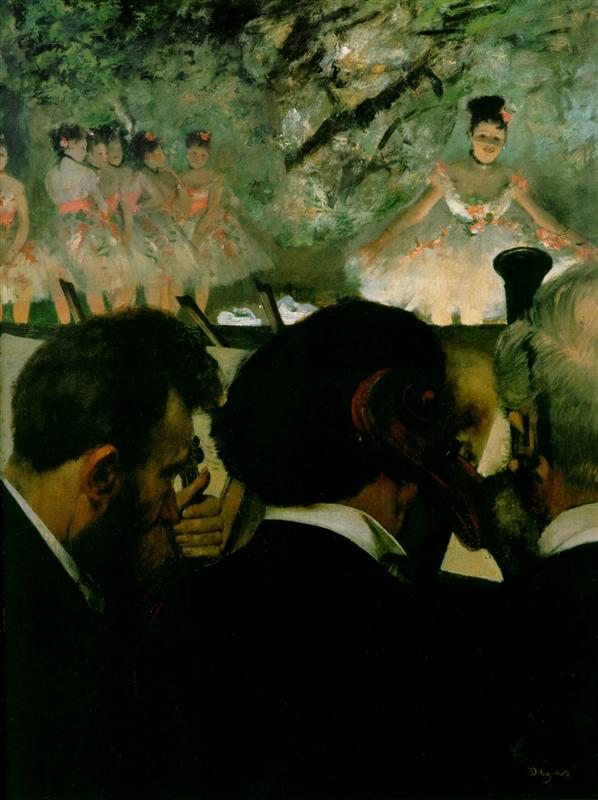
Chopping it down to size
‘Orchestra Musicians’ was originally painted as a much larger piece in a horizontal format. The first version focussed solely on the orchestra with only the dancers’ legs visible. Two years later, Degas returned to the painting and extended the top of the canvas while cutting both sides. This allowed him to add the rest of the bodies of the dancers and more of the set behind them.
While this painting was carefully considered in its composition, it drew on Impressionist techniques in the painting style. The musicians are painted more classically, with less visible brushstrokes and clear lines. In comparison, the work he added later is far looser.
The dresses
Taking for example, the dresses of the ballerinas, Degas denotes the flowy tulle as a mass of white and grey tones. Similarly, the stage decoration is made up of quick, individual brushstrokes to signify the painted greenery. Degas also experiments with the effects of artificial light on the faces and clothes of the ballerinas.
This would later become an object of considerable focus in his paintings from the theatre and cafe concerts.
Where is it now?
Orchestra Musicians is now found in Frankfurt's Stadel Museum.
4. The Rehearsal of the Ballet Onstage (1874)
Among Degas’ dance pictures, this piece was the most regularly exhibited.
‘The Rehearsal of the Ballet Onstage’ was revolutionary for the time, produced from a range of different media that would not be widely adopted until around the middle of the 20th century.
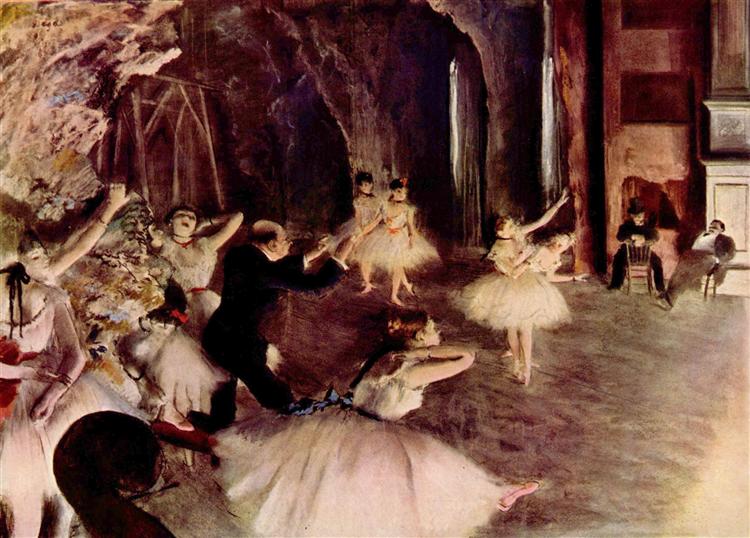
Degas used a combination of oil paints mixed with turpentine, as well as watercolour and pastel. These were applied over a pen-and-ink drawing on wove paper, which was laid on a board and mounted on canvas.
Action beyond the stage
What is evident from this piece is Degas’ interest in the action beyond the stage. He was captivated by the contrast between the spectacle of the ballet and the actions of the dancers at rest.
As one art historian, Carol Armstrong, wrote:
”in almost all of the dance pictures exhibited between 1874 and 1886, there are only small groups of dancers actually dancing, and they are invariably surrounded […] by a crowd of very different occupations: stretching, yawning, scratching, looking distractedly around.”
The 'Patrons'
Also pictured in this work are two male abonnés or patrons, seated in relaxed poses on the right of the stage. These men would have paid for a box at the opera and in return been given access to rehearsals and the backstage during performances from which they could watch the dancers. In many cases, they also acted as clients for the dancers who were expected to work as prostitutes.
Shows
This piece was exhibited at the Third Impressionist Exhibition in 1877. However, Degas chose to show the painting earlier in London in 1876 at the Deschamps Gallery. This may have been motivated by a desire to test the reception for the piece before unveiling it in Paris.
Where is it now?
Rehearsal of the Ballet Onstage is found in The Met, New York.
5. In A Cafe (1875-76)
Also known as ‘l’Absinthe’, ‘Dans un café’ is a bleak and expressive painting.
Degas chose to set the piece in a popular cafe often frequented by the Impressionists known as ‘La Nouvelle Athènes’.
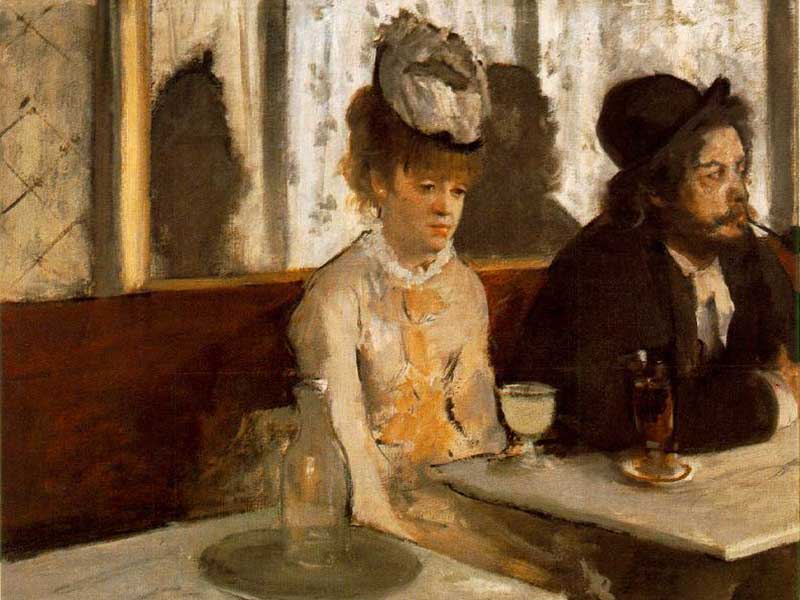
Isolation ...
While the location is fashionable, there is a dark sense of isolation in the two figures depicted in the painting. From the sad expression of the subjects to their hunched poses, Degas establishes these characters as alcoholics. However, he does not criticise them, unlike contemporary paintings and anti-absinthe propaganda from the day.
The viewer is positioned as though seated at a table in the cafe and peering across at fellow patrons. The composition of this painting was inspired by Japanese prints circulating in Europe at this time. Degas was one of the earliest collectors of Japanese art in France.
Unlike other Impressionist artists, Degas did not draw on the same motifs such as mountains and fans but he did borrow heavily from the trend of off-centre framing and asymmetry that was common in Japanese art.
Booing
When the painting was first shown at Christie’s in London in 1892 it was booed by the crowds. Writing in 1893, George Moore stated:
“What a slut! A life of idleness and low vice is upon her face; we read there her whole life. The tale is not a pleasant one, but is a lesson. […] How well the point of view was selected! The beautiful, dissonant rhythm of that composition is like a page of Wagner.”
Where is it now?
In a Cafe is also to be found in the Musee d'Orsay in Paris.
6. Women on a Cafe Terrace, Evening (1876-77)
This is yet another piece by Degas that wrestles with the spectacle of modern, urban life.
In this painting, Degas chose a group of prostitutes sitting in front of a cafe as his subjects.
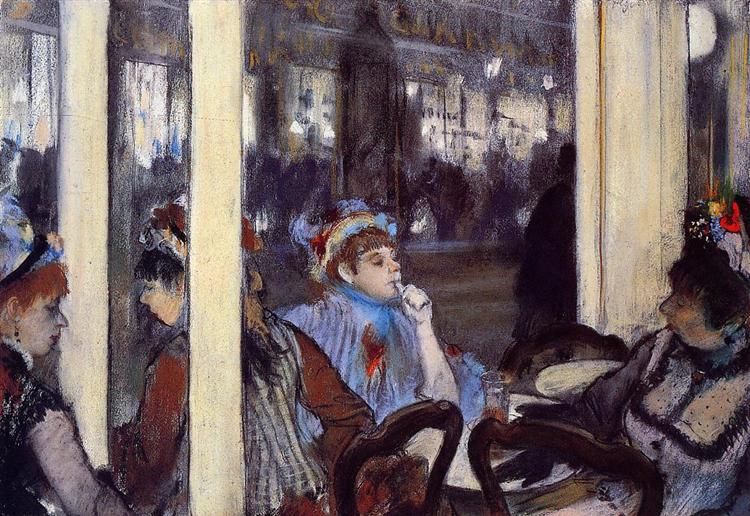
The women have snub noses, deliberately intended to signal their lower social class, a detail that contemporary viewers would have noticed.
People watching ...
The figures are both observing and being observed, seated on a terrace under artificial lighting. The cafe is located on one of the grand boulevards of Haussmann’s Paris and the dark shadows of crowds of people can be seen in the background behind them.
More chopping!
The composition is cropped with the women on both sides of the canvas cut off. At the same time, the columns of the cafe terrace create strong vertical lines in the painting, as well as serving as a place for the shadowy figure of a gentleman to lurk behind. Here we see Degas’ interest in the effects of artificial light too.
Where is it now?
Musee d'Orsay, Paris.
7. Two Dancers Practicing At The Barre (1877)
Close to three-quarters of Degas’ artworks feature female subjects.
Among these, there are almost 100 paintings of ballet dancers and over 300 pastels. In these paintings, Degas reveals the physical labour involved in dance and art.
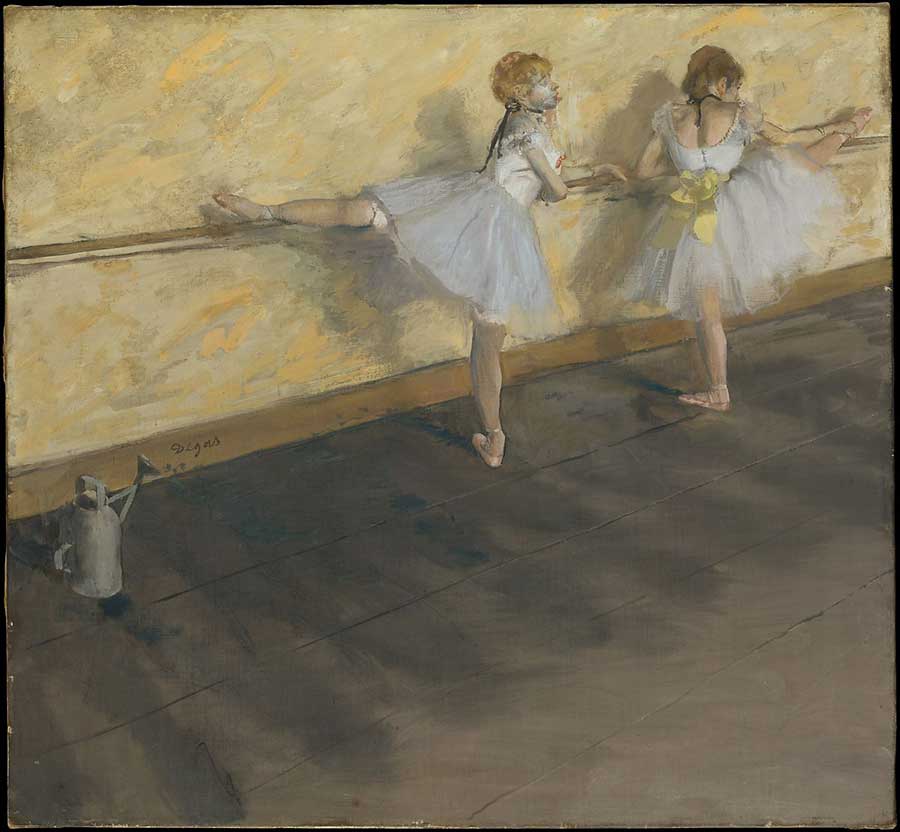
Realistic poses
Through his paintings of dancers resting, stretching, and rehearsing, he did away with Romantic images of the virtuoso ballerina and instead painted ordinary bodies hard at work.
The watering can on the left side of the painting mimics the shape of the young ballerina’s body. This would have been used to sprinkle water on the floor in order to dampen the dust when the ballerinas were dancing. In this setting, it also serves as a metaphor for the dancers themselves: functional, unadorned and unvalued.
Pursuit of perfection ....
Susan Tenneriello draws a link between Degas’ interest in the toil of the dancers and his own pursuit of perfection in his painting: “His fixation on the ballet dancer revealed the methodical routine, the fatigue, and the precision required of a demanding performance discipline—an attitude toward discipline he shared.”
‘Two Dancers Practicing At The Barre’ is a mixed media painting. Degas made at least three preparatory studies before executing this piece.
He exhibited the work at the Third Impressionist Exhibition in April 1899. The painting was later purchased by Louise Havemeyer in 1912, who paid $95,700 for the piece, marking a record price for the work of a living artist.
Where is it now?
Two Dancers at the Barre is now found in New York's Metropolitan Museum.
8. Miss La La At The Cirque Fernando (1879)
Like his paintings of ballet dancers, Degas’ ‘Miss La La At The Cirque Fernando’ focusses on movement and strength.
He paints a famous acrobat and aerialist, Miss La La or Olga, performing at the Cirque Fernando in Paris.
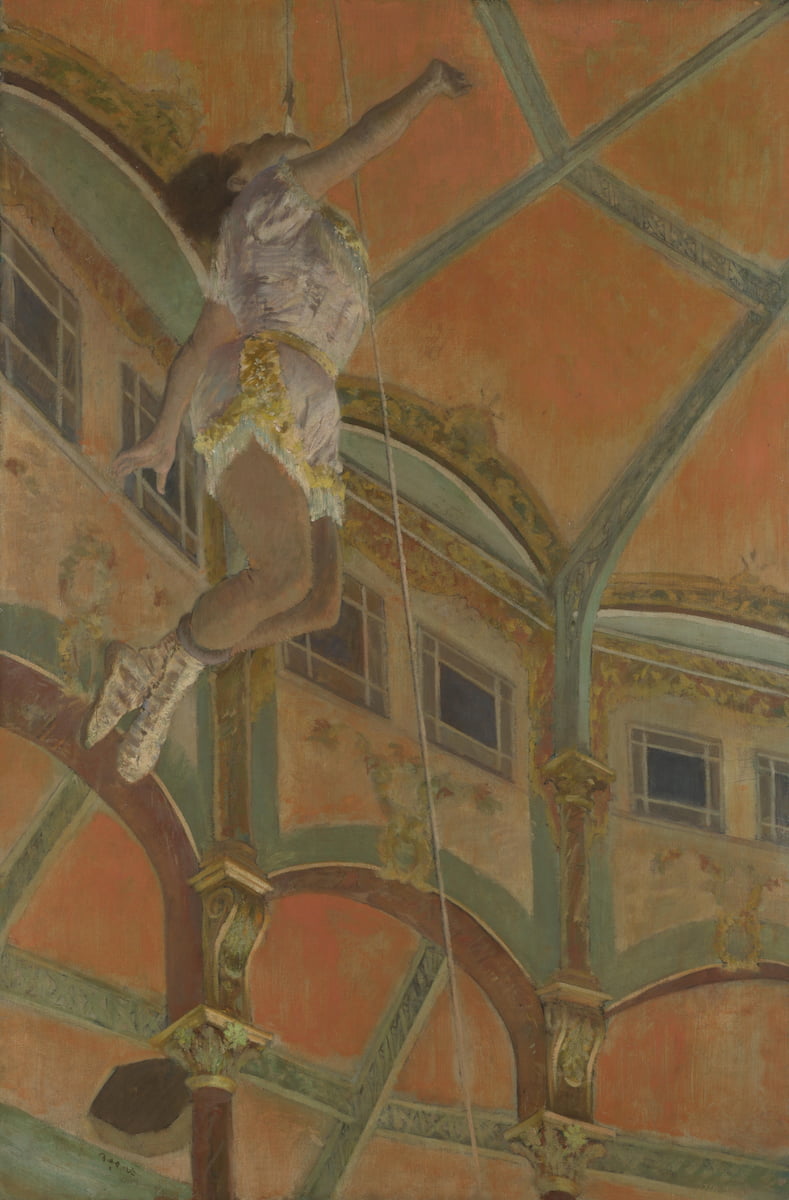
Perfect perspective
What is most striking about this painting is Degas’ use of perspective. The figure of the acrobat is positioned high up and to one side of the composition so that much of the painting is of the roof of the circus.
To achieve the effect, Degas enlisted the help of an architectural draughtsman to help him capture the windows, beams and decoration of the building. It is possible that Degas was inspired to create this piece from the ceiling paintings of Italian Baroque and Rococo artists like Giovanni Battista Piazzetta.
Miss La La
The figure of Miss La La, shown during one of her acts in which she was suspended from the ceiling by a rope between her teeth, reflects the lines of the building. Her arms and lower legs tun parallel to the lines of the girders while her body takes the same form as the vertical supports.
This painting also echoes religious paintings showing saints ascending to heaven. In this modern context, the saint is a working-class circus performer, putting on a spectacle for the crowd.
Where is it now?
Miss La La is found in London's National Gallery.
9. Mary Cassatt (1880-84)
Mary Cassatt modelled in a number of Degas’ paintings during the period of their close friendship.
In this piece, she is shown seated on a wooden chair, leaning forward while clasping cards in her hands.
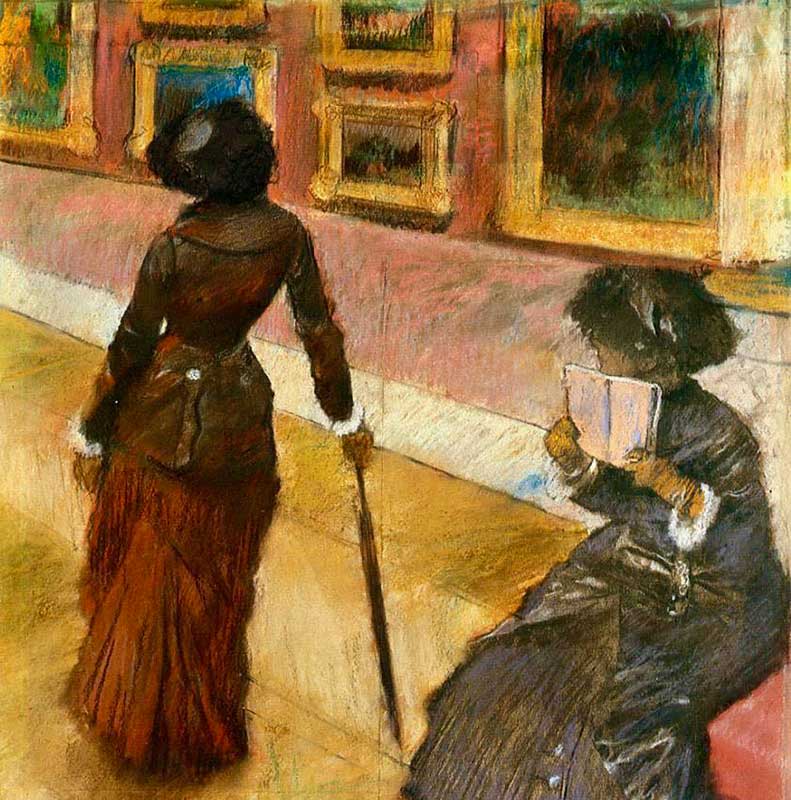
Her pose is casual, almost confiding. These may be playing cards or they could be photographs, maybe reproductions of works of art. It is difficult to be sure of the setting but it is thought to perhaps be a photography studio.
Unknown date
The exact date for the piece is unknown but it is likely to be from the early 1880s as it echoes his other work from this period, especially in the muted colour palette. Further, Cassatt’s appearance is similar to Degas’ prints of her from around this time.
Cassatt and Degas
Mary Cassatt and Degas had a hugely significant friendship, which helped them both grow as artists in their own right. Cassatt appreciated the technical skill of this painting but she did not like her pose or her expression. The painting was in her possession until the 1900s when she contacted a dealer in Paris to sell it on her behalf, around 1913.
She requested that the dealer make sure it did not go to an American collection to make sure that her family and friends did not see it.
Where is it now?
Sadly, Degas' Mary Cassatt is held in a private collection (though it is occasionally exhibited).
10. Women Ironing (1884-86)
As a committed painter of modern life, Degas developed a keen interest in painting working-class women in Paris.
Many of these works centred on milliners and washerwomen, and they featured heavily in his works for as long as 25 years, between 1869 and 1895.
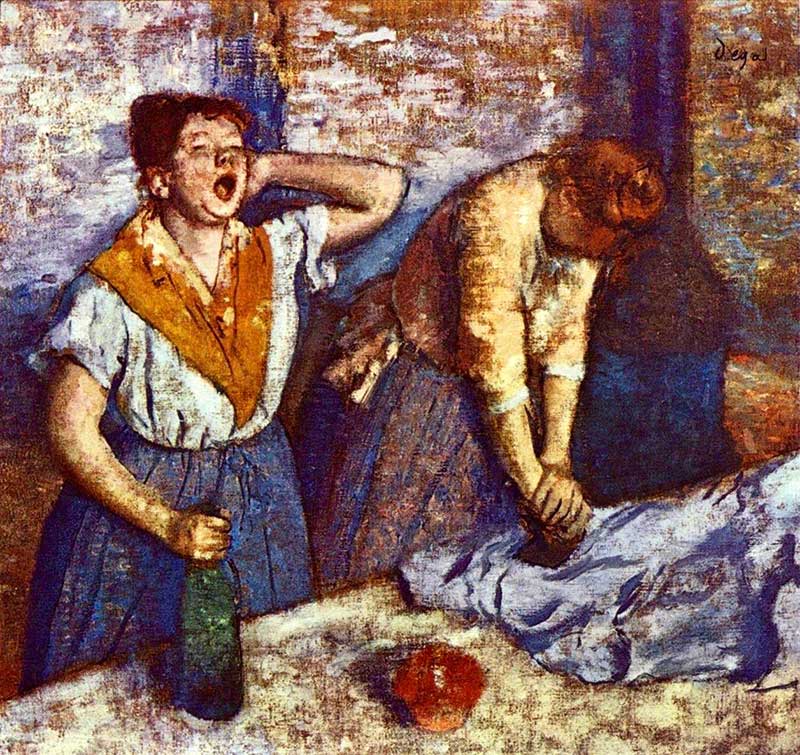
Different variations
‘Women Ironing’ was painted in four different variations by Degas, between 1884-86. Every piece depicts one woman yawning while the other woman leans on her flat iron. In choosing these poses for the figures, Degas referenced the work of Naturalist authors like Emile Zola, who sought to give an accurate portrayal of the life of the urban poor.
Hard work
In this painting, it is possible to see the reality of the physical effort involved in laundry work. The woman on the right presses with both hands on the iron, putting her whole body weight into the movement. Meanwhile, the woman on the left displays her obvious weariness. The scene is not romanticised.
Rough and ready ...
The technique Degas used to paint this piece was also deliberately rough. He applied oil paint directly onto the canvas, without an undercoat. He painted quickly, leaving areas of the canvas visible under the paint.
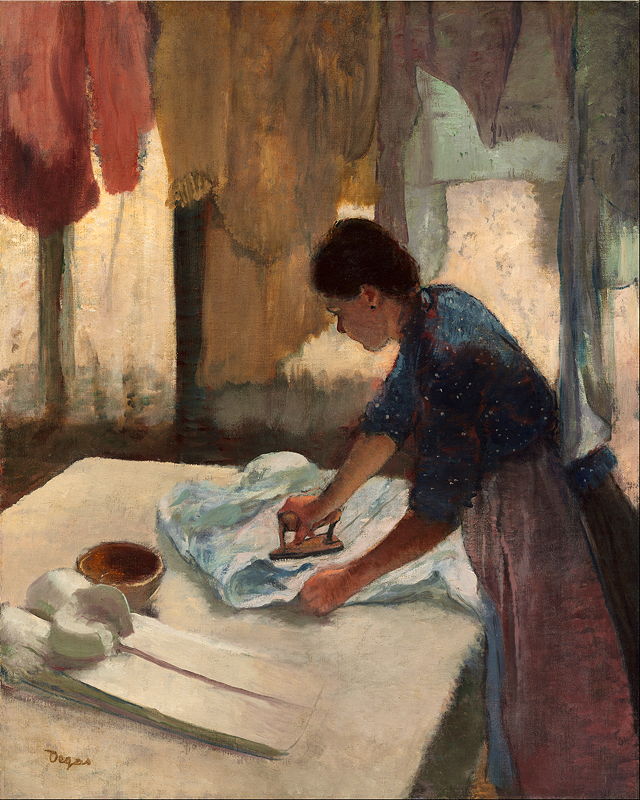
Where is it?
Women Ironing is found in Paris' Musee d'Orsay.
11. What's next?
When you are done with this page, why not check out:
- Our Edgar Degas Biography page.
- Our Top 10 Impressionist Paintings page.
- Our Impressionism Timeline page.

